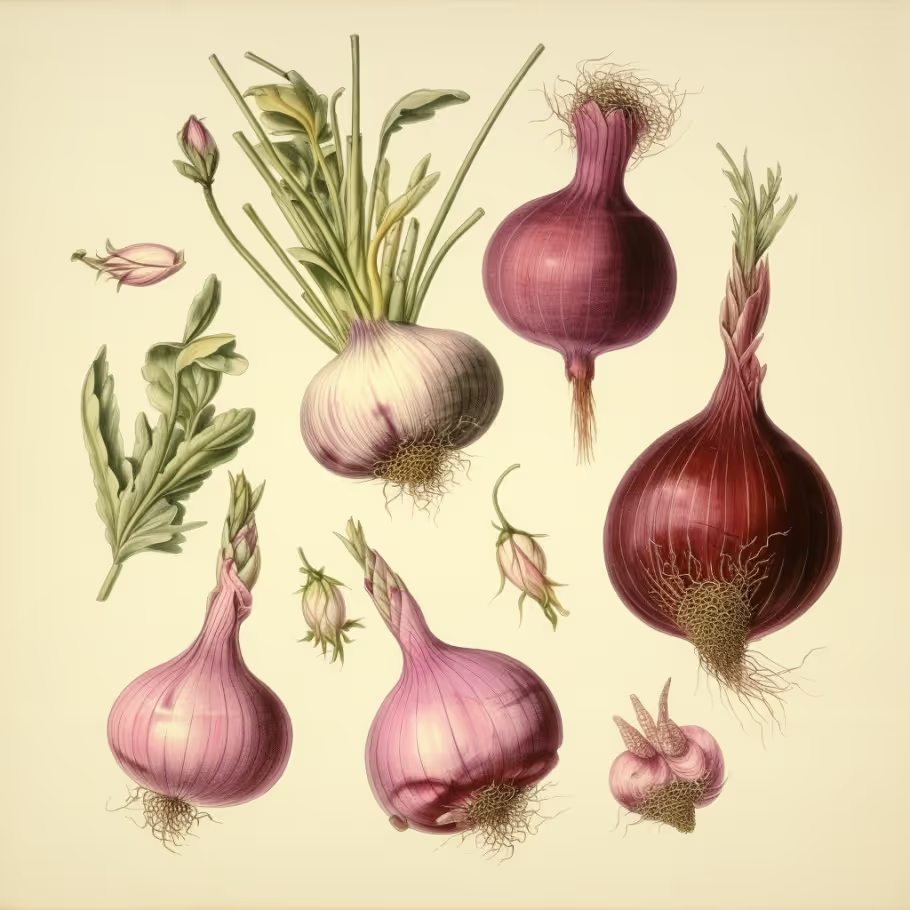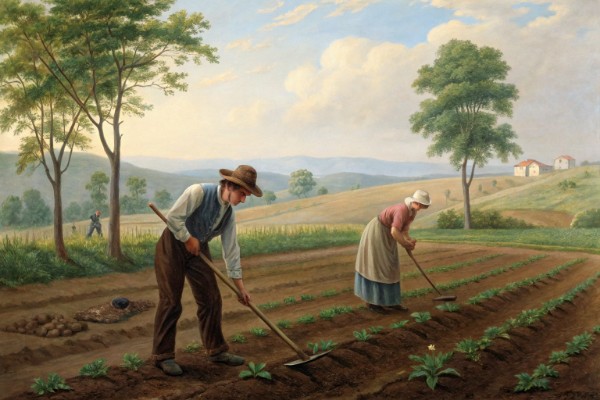Types of Onions: A Guide to Varieties for Every Garden

Types of Onions
Mastering your culinary garden starts with knowing the distinct types of onions at your fingertips. Yellow onions caramelize deeply for hearty stews, red onions slice crisp and spicy into fresh salads, and sweet onions roast mellow, perfect for grilling. Here's how to choose, grow, and savor these flavorful bulbs—your guide to delicious onion simplicity awaits.
🧅 Quick Cheatsheet: Diverse Onion Types & Tips
🌱 Popular Onion Varieties & Uses
- 🟡 Yellow Onion: Rich flavor; ideal for soups, stews, sauces.
- ⚪ White Onion: Sharp taste; great raw in salsa, sandwiches, salads.
- 🔴 Red Onion: Mild, sweet; best raw or pickled, salads, garnishes.
- 🌰 Shallot: Mild, delicate; sauces, dressings, gourmet dishes.
- 🧄 Sweet (Vidalia, Walla Walla): Sweet, crisp; raw salads, sandwiches, relishes.
- 🌿 Green Onion (Scallion): Mild, fresh; garnish, salads, Asian dishes.
- 🟤 Pearl Onion: Sweet, mild; pickling, roasting, stews.
- 💜 Leek: Mild, aromatic; soups, stocks, potato dishes.
🍽️ Cooking & Flavor Tips
- 🔥 Caramelize slowly on low heat (20-40 min) for sweet depth.
- 🧊 Chill onions before cutting to reduce eye irritation.
- 🥘 Use mild onions (Sweet, Shallot, Red) fresh; strong onions (Yellow, White) cooked.
🥦 Health & Nutrition Quick Facts
- 💊 Rich in antioxidants (quercetin) and vitamin C.
- 🩺 Supports immunity, heart health, inflammation reduction.
- 🥗 Raw onions offer highest nutritional value.
🌾 Growing & Storage Essentials
- 🌞 Full sun (6+ hours daily), loose soil, good drainage.
- 📅 Plant early spring, harvest after tops yellow and fall over.
- ❄️ Store harvested onions cool, dry (35-50°F / 1-10°C), good airflow.
- 🕓 Properly cured onions store up to 6 months.
📈 Intriguing Onion Stats
- 🌎 Global onion production: ~106 million tons annually.
- 🇺🇸 Average American eats about 20 lbs (9 kg) onions per year.
The Many Layers: Exploring the Types of Onions for Your Garden
Onions have always fascinated me. I remember one crisp morning, harvesting my first batch of glossy red onions, their pungent scent hanging thick in the dawn air.
Few vegetables reward gardeners so handsomely with such minimal fuss. But here's the key: you'll want to know your varieties.
Yellow Onions: The All-Rounder
If your kitchen resembles mine, yellow onions occupy pride-of-place. Their savory sweetness lends itself effortlessly to stews, soups, and sauces.
Tip: Store yellow onions at around 40°F (4°C) in a cool, dry pantry—they'll last months without losing their flavor.
Red Onions: The Vibrant Sweetheart
At garden parties, I often slice raw red onions razor-thin and toss them into fresh green salads. Their mild sweetness and crispy texture brighten any dish.
Bonus: their vibrant red-purple color adds visual flair to your plate and to your garden beds.
White Onions: Bright Bite
White onions surprise newcomers with their sharp, pungent snap. I prefer them finely chopped into spicy salsas or pickled alongside fiery chilies for tacos.
Garden-wise, they're slightly more perishable after harvest. Use them within weeks to maintain their crisp texture and assertive taste.
Sweet Onions: Gentle Giants
Ever tasted a Vidalia or Maui onion fresh from the garden? You'll find these sweet varieties invitingly mild, juicy, and perfect for caramelizing.
"Sweet onions contain a higher water and sugar content, decreasing their storage life but increasing their caramelization potential."
I grow mine where they soak up plenty of sun, then grill them whole on summer evenings. Pure gardening bliss.
Scallions (Green Onions): Tender and Timely
My raised beds always reserve a row for scallions. Quick-growing—about 60 days—and adaptable, they deliver tender green stalks and subtly mild bulbs.
Snipping their tops for omelets and garnishes is a regular ritual in my kitchen.
Shallots: Small Wonders
Shallots stand apart as delicate, gourmet members of this pungent family. With their subtle sweetness and mellow flavor, they're perfect roasted whole or minced into vinaigrettes.
In my garden, shallots thrive easily, multiplying into generous clumps if planted in autumn's cooler temperatures around 50°F (10°C).
Leeks: Elegant Stalks of Flavor
Technically, leeks belong to the onion family, but their flavor and texture merit special mention. I often braise them gently in butter or blend them into a velvety potato leek soup when autumn chills set in.
They necessitate depth of soil or trench planting to produce tender white stalks—extra effort that's entirely worth it.
Top Onion-Growing Tips From My Garden
- Direct sow seeds early: Onions crave a long, cool start; plant seeds 4–6 weeks before the last frost, at 35–50°F (2–10°C).
- Full sun, please: Ensure at least 6–8 hours daily for vigorous growth.
- Moisture matters: Consistent watering—about 1 inch (2.5 cm) per week—prevents bulbs from stressing, cracking, or prematurely bolting.
- Harvest with care: Lift onions gently once foliage yellows and falls over; let them cure in a dry, airy spot for longevity.
Every onion variety brings a unique set of gifts to my garden and my plate. By choosing cleverly among these varied types, you'll savor delicious rewards season after season.
Frequently Asked Questions About Types of Onions
What onion varieties are ideal for salads?
Choose red onions or spring onions (scallions) for salads. Their mild flavor and satisfying crunch complement fresh greens and raw vegetables, enhancing overall salad texture and taste.
How can I select the best onions for caramelizing?
Yellow onions provide the ideal balance of sweetness and pungency, ideal for caramelizing. Slow-cooking these onions gradually converts their natural sugars, resulting in a deep, richly sweet flavor perfect for soups, burgers, or savory tarts.
Which onions have the longest shelf-life?
Storage onions, particularly yellow and white varieties, maintain freshness longer if stored in a cool (32-40°F / 0-4°C), dry, dark, and well-ventilated area. Properly stored, they'll last from 1 to 2 months or even more, maintaining firmness and flavor.
What onion varieties flourish in colder climates?
Long-day onions, such as 'Walla Walla' or 'Copra,' thrive in northern climates. Plant them early in spring, allowing 14-16 daily sunlight hours to stimulate bulb growth and yield healthy, flavorful harvests.
Which varieties are suitable for container gardening?
Spring onions (scallions), shallots, and small-bulbing onion varieties perform exceptionally in containers. Use well-draining soil, at least 6-8 inches (15-20 cm) deep, and ensure adequate sunlight and regular watering for optimal growth.
Can onion types affect cooking outcomes significantly?
Yes, onion variety greatly influences cooking results. Sweet onions like 'Vidalia' or 'Maui' suit eating raw or lightly grilled, while yellow onions provide strength in soups, stews, and sauces. Selecting an appropriate variety improves flavor complexity and harmony within your dishes.
Are shallots interchangeable with other onion varieties?
Shallots impart a subtler, more delicate flavor compared to other onion varieties. Although substitutable in some recipes, shallots shine brightest in vinaigrettes, delicate sauces, and dishes where their refined sweetness enhances rather than dominates.
Do onion cultivation requirements differ by variety?
Yes, onion varieties differ significantly regarding day-length sensitivity, climate preferences, and planting seasons. Short-day onions require approximately 10-12 hours of sunlight daily, suitable for southern climates. Intermediate-day onions need roughly 12-14 hours, thriving in middle regions. Select onion varieties matching your climate and sunlight exposure conditions for the most abundant yield.
Understanding the types of onions is like knowing your spices: it brings nuance and depth to your gardening and your cooking. Sweet onions charm fresh salads, reds add color and bite, while pungent yellows anchor savory dishes with warmth and fortitude. Mastering the art of growing and selecting different onions connects you deeply to the rhythm of your garden and kitchen, each variety a unique opportunity to enhance flavor and texture. Explore freely, cultivate different varieties, and savor the flavorful pleasures that come from truly knowing your types of onions.
Find out which plants will thrive in your garden!
Answer a few fun questions and get custom plant recommendations perfect for your space. Let’s grow something amazing together!

start your season





